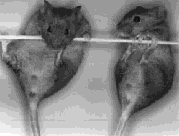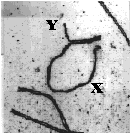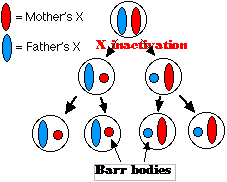
| see Making Transgenic Animals |
The nuclei of human cells contain 22 autosomes and 2 sex chromosomes. In females, the sex chromosomes are the 2 X chromosomes. Males have one X chromosome and one Y chromosome. The presence of the Y chromosome is decisive for unleashing the developmental program that leads to a baby boy.
In making sperm by meiosis, the X and Y chromosomes must separate in anaphase just as homologous autosomes do. This occurs without a problem because, like homologous autosomes, the X and Y chromosome synapse during prophase of meiosis I. There is a small region of homology shared by the X and Y chromosome and synapsis occurs at that region.

This image, courtesy of C. Tease, shows synapsis of the X and Y chromosomes of a mouse during prophase of meiosis I. Crossing over occurs in two regions of pairing, called the pseudoautosomal regions. These are located at opposite ends of the chromosome.

The pseudoautosomal regions get their name because any genes located within them (so far only 9 have been found) are inherited just like any autosomal genes. Males have two copies of these genes: one in the pseudoautosomal region of their Y, the other in the corresponding portion of their X chromosome.
This diagram shows the structure of the human Y chromosome.
12 new genes found on the Y
Until recently, only 8 genes had been found outside the pseudoautosomal regions. However, in the 24 October 1997 issue of Science, Lahn and Page report finding 12 more. Of the new total of 20 different genes, 9 encode proteins used by all cells (and both sexes). The others encode proteins that appear to function only in males. The key player in this latter group is SRY.
SRY (for sex-determining region Y) is a gene located on the short (p) arm just outside the pseudoautosomal region. It is the master switch that triggers the events that converts the embryo into a male. Without this gene, you get a female instead. It appears, then, the femaleness is the "default" program.
What is the evidence?
| see Making Transgenic Animals |
(A test based on a molecular probe for SRY was used to ensure that potential competitors for the women's Olympic events in Atlanta had no SRY gene.)
The X-Y system of sex determination is found in many kinds of organisms besides mammals. The fruit fly, Drosophila, uses such a system as do a number of plants that have separate sexes (e.g., Cannabis sativa, the source of hemp and marijuana). A similar system is found in birds and moths, but here the male has two of the same chromosome (designated ZZ), whereas the female has "heterogametic" chromosomes (designated Z and W).
| X | Y | |
|---|---|---|
| X | XX | XY |
| Xh | XhX | XhY |
Women rarely suffer from hemophilia A because to do so they would have to inherit a defective gene from their father as well as their mother. Until recently, few hemophiliacs ever became fathers.
| Click here for a discussion of red-green colorblindness; another example of X-linked inheritance. |
Human females inherit two copies of every gene on the X chromosome, whereas males inherit only one (with 18 exceptions: the 9 pseudoautosomal genes and the 9 "housekeeping" genes found on the Y). But for the hundreds of other genes on the X, are males at a disadvantage in the amount of gene product their cells produce? The answer is no, because females have only a single active X chromosome in each cell.
During interphase, chromosomes are too tenuous to be stained and seen by light microscopy. However, a dense, stainable structure, called a Barr body (after its discoverer) is seen in the interphase nuclei of female mammals. The Barr body is one of the X chromosomes. Its compact appearance reflects its inactivity. So, the cells of females have only one functioning copy of each X-linked gene - the same as males.

X-inactivation occurs early in embryonic development. In a given cell, which of a female's X chromosomes becomes inactivated and converted into a Barr body is a matter of chance (except in marsupials like the kangaroo, where it is always the father's X chromosome that is inactivated). After inactivation has occurred, all the descendants of that cell will have the same chromosome inactivated. Thus X-inactivation creates clones with differing effective gene content. An organism whose cells vary in effective gene content and hence in the expression of a trait, is called a genetic mosaic.
Inactivation of an X chromosome requires a gene on that chromosome called XIST.
X-inactivation in the female embryo appears to be entirely random. There is no predicting whether it will be the maternal X or the paternal X that is inactivated in a given cell. But that is not the case for her extraembryonic membranes (that go on to form the amnion, placenta, and umbilical cord). In all the cells of the extraembryonic membranes, it is father's X chromosome that is inactivated.
What about those 18 genes that are found on the Y as well as the X? There should be no need for females to inactivate one copy of these to keep in balance with the situation in males. And, as it turns out, these genes escape inactivation in females. Just how they manage this has yet to be discovered.
| Welcome&Next Search |